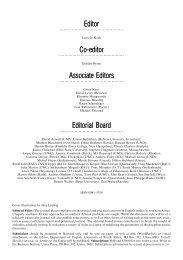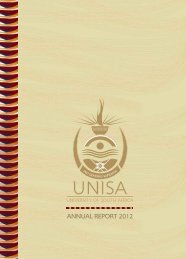Download the Annual report 2011 - Unisa
Download the Annual report 2011 - Unisa
Download the Annual report 2011 - Unisa
You also want an ePaper? Increase the reach of your titles
YUMPU automatically turns print PDFs into web optimized ePapers that Google loves.
RISK MITIGATION PLANS<br />
UNISA ANNUAL REPORT <strong>2011</strong><br />
Inadequate and • New ICT organisational structure<br />
deficient ICT approved; population of <strong>the</strong> new<br />
resources and structure on track<br />
capacity to support • ICT Policy Framework outlining<br />
<strong>the</strong> institutional all policies needed has been developed<br />
requirements • ICT high-level key risks and root causes<br />
(Strategic goal 7) identified and risk assessment completed<br />
• <strong>Unisa</strong> 2015 Future-State ICT framework<br />
approved<br />
• ICT project management performance<br />
<strong>report</strong> reviewed regularly<br />
• Change management process implemented<br />
to improve and maintain ICT<br />
service delivery<br />
• ICT is currently ISO 9001: 2008 certified<br />
Insufficient available • Enrolment plan and statement<br />
institutional resources submitted to <strong>the</strong> Department<br />
to adequately service of Higher Education and Training<br />
growing student • Development of an integrated<br />
numbers tutor model<br />
(Strategic goal 7) • Definition and development of an<br />
ODL regional model<br />
• University Property Plan has been updated<br />
in line with <strong>the</strong> new enrolment planning<br />
targets<br />
Failure to sustain and • Institutional Research Strategy and Plan<br />
enhance research output developed and approved per capita<br />
(Strategic goal 2) • Dedicated Research and Innovation<br />
Portfolio created<br />
• Recruitment plans to identify scholars and<br />
young outstanding researchers for ratings<br />
for each college have been drawn up<br />
• Workshops and internal peer review<br />
panels are already in place and individual<br />
coaching of staff to prepare <strong>the</strong>ir research<br />
applications is ongoing<br />
• Positioning of <strong>Unisa</strong>’s research profile<br />
and promoting of research highlights<br />
• Showcasing of <strong>the</strong> researchers who<br />
received NRF ratings and research-related<br />
awards<br />
Failure to sustain and • An effective tracking system has been<br />
enhance <strong>Unisa</strong>’s success developed<br />
and throughput rate • An online examinations process for disser-<br />
(Strategic goal 1) tations and <strong>the</strong>ses is to be developed<br />
• Processes and procedures are in <strong>the</strong><br />
process of being developed to support<br />
<strong>the</strong> implementation of alternative<br />
assessment practices<br />
• Academic staff members have attended<br />
assessor and moderator training; academic<br />
staff members have been introduced to<br />
new assessment practices<br />
• Pilot testing phase on online submission<br />
of examination question papers currently<br />
in progress<br />
• Mobile platform for submission of<br />
answers to multiple-choice questions<br />
implemented<br />
Inadequate succession • Comprehensive talent management<br />
plan for an ageing plan developed and approved<br />
cohort of skilled and • Reward strategy implemented<br />
experienced staff • Identification and acknowledgement of<br />
(Strategic goal 4 & 7) high performers<br />
• Leadership and mentorship programmes<br />
launched<br />
• Two workshops on Creativity and<br />
Innovation for Academic and Professional<br />
Staff conducted<br />
• Guidelines developed for line managers<br />
to facilitate career discussions<br />
| 59 |<br />
However, recognising that risk management is an<br />
ongoing evolving capability, <strong>the</strong> remediation strategy<br />
which <strong>the</strong> university has adopted is an investment<br />
in continuous awareness and improvement<br />
and it is hoped that <strong>the</strong> emerging positive changes<br />
will inspire fur<strong>the</strong>r action. There are some challenges<br />
ahead particularly with regard to developing<br />
risk management capabilities that are adequate for<br />
<strong>the</strong> needs and complexities of <strong>the</strong> university in <strong>the</strong><br />
future. These however are being addressed in a<br />
systematic and incremental manner. Specific risk<br />
areas include:<br />
• <strong>the</strong> types of risks to which <strong>the</strong> university is exposed,<br />
as well as <strong>the</strong>ir criticality factor, is growing<br />
and <strong>the</strong>se range from supply chain to operations<br />
to regulations and to reputation. Recognising<br />
emerging trends and <strong>the</strong> growing scourge of<br />
fraud and corruption, <strong>the</strong> university has also increased<br />
its focus in this area within <strong>the</strong> organisation.<br />
(A special fraud and corruption <strong>report</strong> is<br />
presented in <strong>the</strong> following section.)<br />
• performance gaps exist between expectations for<br />
risk management and what is actually achieved,<br />
given that this has not been a priority focus of<br />
<strong>the</strong> institution and general organisational knowledge<br />
is limited.<br />
• <strong>the</strong> need to infuse risk awareness across <strong>the</strong> organisational<br />
culture is not a process that can be<br />
fast-tracked if one wants to ensure institutional<br />
buy-in to <strong>the</strong> process (as opposed to a more surface<br />
and superficial approach).<br />
Finally, it is reiterated that in a world of continued,<br />
dramatic, changing commitment to stakeholder<br />
value and strategic output, <strong>the</strong> risk management<br />
process is dynamic and involves continuous engagement<br />
with as well as a periodic review of institutional<br />
risks. The control responses to achieve<br />
long-term competitive advantage and high performance<br />
are accordingly continually updated to<br />
ensure that <strong>the</strong> appropriate remedial measures are<br />
aligned with <strong>the</strong> institutional strategic and operational<br />
plans.<br />
Advocate V Kahla<br />
Chairperson: Audit and Enterprise Risk<br />
Committee of Council<br />
Professor D Singh<br />
Chairperson: Risk, Ethics and Controls<br />
Committee

















